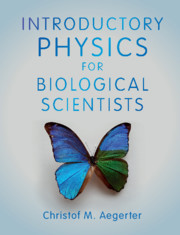
- Publisher:
- Cambridge University Press
- Online publication date:
- October 2018
- Print publication year:
- 2018
- Online ISBN:
- 9781108525862
Last updated 10th July 2024: Online ordering is currently unavailable due to technical issues. We apologise for any delays responding to customers while we resolve this. For further updates please visit our website https://www.cambridge.org/news-and-insights/technical-incident


Why do elephants have sturdier thigh bones than humans? Why can't ostriches fly? How do bacteria swim through fluids? With each chapter structured around relevant biological case studies and examples, this engaging, full-colour book introduces fundamental physical concepts essential in the study of biological phenomena. Optics is introduced within the context of butterfly wing colouration, electricity is explained through the propagation of nerve signals, and accelerated motion is conveniently illustrated using the example of the jumping armadillo. Other key physical concepts covered include waves, mechanical forces, thermodynamics and magnetism, and important biological techniques are also discussed within this context, such as gel electrophoresis and fluorescence microscopy. A detailed appendix provides further discussion of the mathematical concepts utilised within the book, and numerous exercises and quizzes allow readers to test their understanding of key concepts. This book is invaluable to students aiming to improve their quantitative and analytical skills and understand the deeper nature of biological phenomena.
 Loading metrics...
Loading metrics...
* Views captured on Cambridge Core between #date#. This data will be updated every 24 hours.
Usage data cannot currently be displayed.